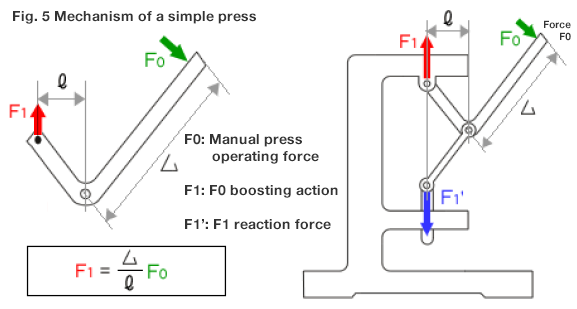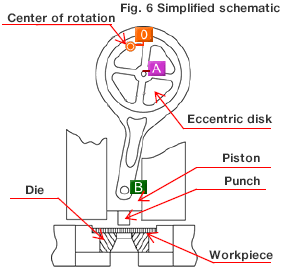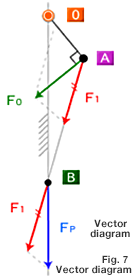(!)Due to
Microsoft's end of support for Internet Explorer 11 on 15/06/2022, this site does not support the recommended
environment.
Instead, please kindly use other browsers like Google Chrome, Microsoft Edge or Mozilla
Firefox.
- Notice of End of Sales for Economy Series Pneumatic Equipment Category. More details.
Usage Example of Booster Mechanism (Fundamentals of Booster Mechanism)
Part 5 in the Fundamentals Series. Could you move the earth using leverage? An introduction to booster mechanisms with examples of how levers, toggles and crank mechanisms are used
- Boost mechanisms and lever mechanisms
- Toggle mechanism
- Usage example of booster mechanism
Usage example of booster mechanism (1) Simple press using a lever

The mechanism shown in Fig. 5 is a simple press that combines a bell crank and a toggle joint crank.
Force (F0) applied to the bell crank handle gains booster (F1) by the booster mechanism in proportion to the arm length ratio,
and this force is supported by the press housing. That reaction force is redirected in the opposite direction by the toggle joint to become the pressing force (F1').
Application example of booster mechanism (2) Press using a crank and toggle mechanism


The mechanism in Fig. 6 is a press in which crank OA uses an eccentric disk so that the disk weight presses the workpiece when the disk center (=center of gravity) is below the center of rotation O.
In that, a crank and toggle mechanism is used.
Fig. 7 is a vector diagram of this mechanism, and a vector comparison of the forces at link A and machining point B shows that a boosting action is obtained.
In other words, F0 is increased by using an eccentric disk, and then the piston deflects it vertically to obtain the press force Fp with this mechanism.
How long of a lever is needed to move the earth?
“Give me a lever long enough and a fulcrum on which to place it, and I shall move the world.” So goes the saying by Archimedes.
So, can the earth be moved with a lever? If possible, how long does the lever need to be? Let’s calculate it.
Assuming that the weight of the Earth is 5.9736 × 1024 kg, or approx. 6 × 1024, and that Archimedes' weight is 50 kg and the distance from the fulcrum to the point of action is 1 km, the distance d from the fulcrum to the point of effort can be found assuming that the moment at the point of effort is balanced by the moment at the point of action.

Distance from the fulcrum to the point of effort
| 50kg | × | d | = | 6×1024kg | × | 1km |
| Archimedes' weight (force applied at the point of effort) |
Distance from the fulcrum to the point of effort | Weight of the Earth | Distance from fulcrum to the point of action 1 km |
| d | = | 6×1024 kg × 1km | = | 1.2 × 1023 km |
| 50kg |
If the distance from the fulcrum to the point of effort is 1.2 × 1023 km and the distance from the fulcrum to the point of action is 1 km, the required lever length is 120,000,000,000,000,000,000,001 km.
It takes approx. 120,000,000,000,000,000,001 hours by plane flying at 1,000 km/h.
Even assuming that a person lives to 100 years, the distance would be 136,986,301,000,000 hours, so it would take approx. 136 trillion hours to fly there.
Unless people's lifespans increase dramatically, this will be impossible to achieve.